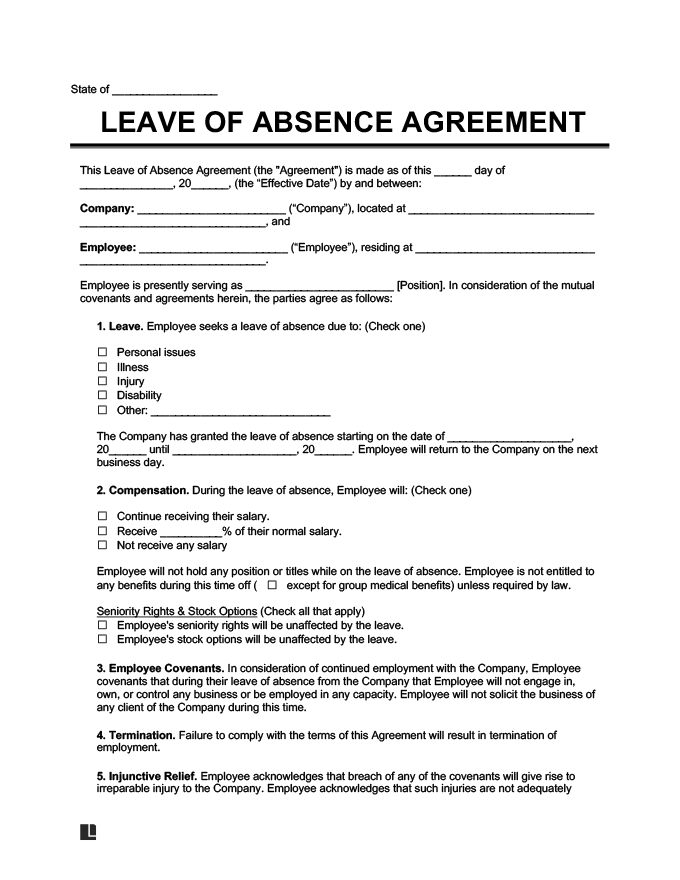A leave of absence agreement is a written agreement between an employer and an employee that documents the terms and conditions of an employee’s leave of absence from a business.
It grants an employee an absence from their job for a specific length of time so they may attend to other matters. The employer agrees to hold the employee’s job (or a similar position) for the employee upon their return from leave. The employee agrees to return at a specified time.
Supplemental Forms
Before entering this agreement, the employee typically submits their formal request via a leave of absence letter.
A time-off request form may be sufficient for short absences. However, please note that some companies require a leave of absence agreement for any kind of leave, even if it only lasts a couple of days.
What to Include in a Leave of Absence Agreement
Employee Information: Identify the employee and employer, including their names and addresses. State the employee’s current title.
Leave Details: Specify the reason the employee is taking leave, the start date, and the anticipated end date of the leave.
Paid or Unpaid Leave: Clarify whether the leave will be paid or unpaid.
Benefits Continuation: Clarify if the employee will continue receiving their salary, health insurance, and other benefits during the leave.
Job Security: Indicate whether the employee’s position will be held open for their return. If not, mention if they will be considered for other open positions.
Responsibilities During Leave: Specify any expectations of the employee while on leave.
Return to Work Procedures: Detail the process for the employee to return to work, including any required documentation or meetings.
Leave of Absence Extension: In situations where an extension may be required, such as when dealing with an illness, you should address extension details comprehensively.
Termination Clause: Outline the conditions under which the leave may be converted to termination of employment by either party.
Other Details to Include
Additionally, you should include the following details about the leave of absence:
- Whether the employer expects reports about the status of the leave on an ongoing basis;
- Whether the employer expects a physician’s statement, either during ongoing leave or as a condition of returning to work;
- Specify how company property, such as laptops or phones, will be handled during the leave;
- The consequences are if the employee doesn’t meet the terms and conditions of the agreement.
Benefits of a Leave of Absence Agreement
Explore some of the benefits of a leave of absence agreement:
- Ensures Legal Compliance: A leave of absence agreement protects both parties and ensures that they adhere to relevant legal requirements and the established governing law. By clearly outlining the leave’s terms, including eligibility criteria and rights protected under federal and state laws such as the Family and Medical Leave Act (FMLA), the agreement mitigates legal risks.
- Promotes Clarity: A leave of absence agreement defines the terms and conditions of the leave period, providing clarity for all parties. By specifying details such as the duration of the leave, expected conduct during the absence, and documentation requirements, the agreement reduces the likelihood of misunderstandings.
- Enhances Communication: A written agreement defining and formalizing the terms of the leave lets an employer and employee enhance their communication. The agreement serves as a reference point for discussions related to the leave, facilitating open communication and fostering a positive relationship between the parties.
- Promotes Development: A well-crafted agreement can promote employee development and well-being. The agreement supports their personal and professional growth by providing opportunities for them to attend classes or training sessions and care for loved ones. Furthermore, it lets a company maintain a valuable employee’s position.
When Is a Leave of Absence Agreement Necessary?
A leave of absence agreement is usually necessary to grant employees extended or unpaid leave.
Leave of Absence Agreement Sample
Frequently Asked Questions
I want to spend three weeks hiking and camping. Can I make my employer sign a leave of absence agreement?
No. Hiking and camping are not activities covered under the Family Medical Leave Act or the Americans with Disabilities Act. Your employer is not required to grant you unpaid leave for this activity. However, you could request an unpaid sabbatical since there is nothing prohibiting your employer from entering into an unpaid leave agreement if they are so inclined.
I want to use my saved vacation time to help a family member in need. Do I need a leave of absence agreement?
No. A leave of absence agreement is designed for situations where you are taking leave that is not covered by sick time, vacation time, or personal leave time.
Can I take a leave of absence due to work-related stress?
Yes, your workplace may let you take a leave of absence due to work-related stress if the stress is causing physical and mental health problems. During your absence, you can identify stressors, develop management techniques, and attend medical appointments to seek help.


